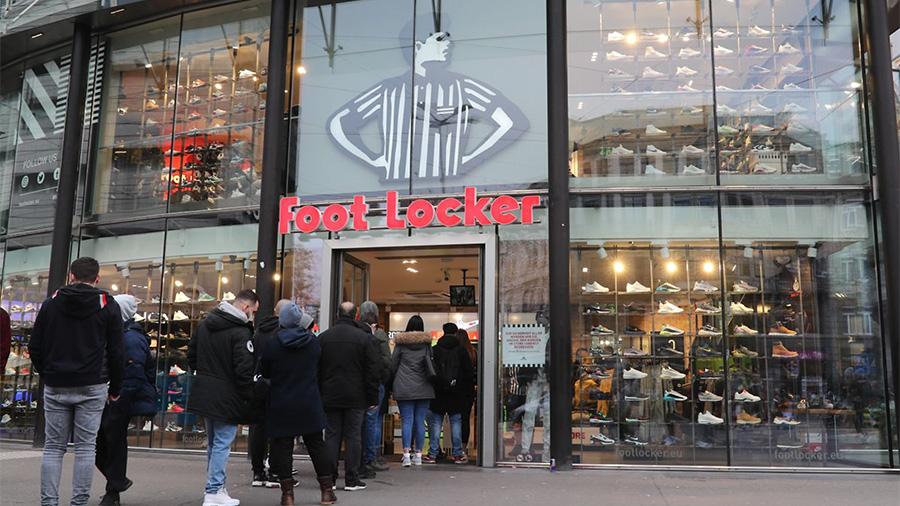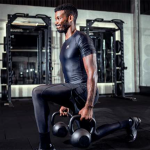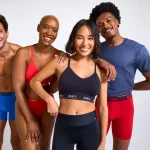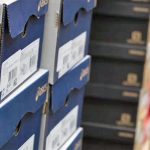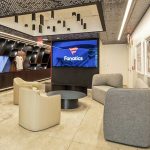Foot Locker raised its guidance for the full year after reporting better-than-expected third-quarter results with a boost from strong demand and full-price selling. Officials expressed confidence they’ll be able to offset the severe supply chain headwinds in coming quarters.
Shares of Foot Locker nonetheless were down 12 percent in mid-day trading on the New York Stock Exchange due apparently to supply chain concerns
Supply Chain Mitigation Steps
Addressing the global supply chain challenges early on in the conference call, Dick Johnson, Foot Locker’s chairman and CEO, said, “We’re all aware of the challenges. It’s a fluid situation that we are making every effort to manage and we do have a few advantages.”
First, he said Foot Locker is well diversified across its banners with a diversified product mix reaching a broad range of consumer needs across price points and can lean on strong vendor partnerships. Johnson said, “We like our position in terms of our assortment of brands, and we benefit from the very strong partnerships we have built with them over many decades. In times like these, our partnerships are mutually beneficial, enabling us to work together as far into the future as possible to plan, collaborate and be solution-oriented.”
Second, carrier capacity “is something we always keep a close eye on” and the company is “much better positioned this year than in the past,” including with FedEx, UPS, its pool carriers, and U.S. Postal Service. Said Johnson, “We’ve got better visibility than we’ve ever had of where their hot spots are so we can manage customer expectations appropriately.”
Third, Foot Locker is comfortable with its distribution center staffing and capacity levels and is building adding some additional flex capacity for the fourth quarter.
Finally, Foot Locker remains focused on leveraging “the advantage that having approximately 3000 stores globally offers us to serve our customers and deliver the types of diversified product offerings, inclusive of apparel, accessories and complementary products, that our customers come to us for.”
Three Factors Driving Demand
From a demand standpoint, Johnson cited three macro trends working he believes are working in Foot Locker’s favor.
“Number one is the democratization of sneaker culture with more brands and more consumers participating in the ecosystem of sneaker culture,” said Johnson. “With our position as a multi-branded retailer through Foot Locker, Kids Foot Locker, Champs Sports x Eastbay, and now WSS and Atmos, we have an incredible connection to the marketplace and consumers.”
Second, Johnson believes Foot Locker will benefit from a growing emphasis on fitness and self-care as people continue to look to offset stress and work-from-home conditions by staying active to maintain their physical and mental wellness. Said Johnson, “Whether it’s home fitness, running, training, hiking or any number of other sport fitness categories, we see consumers are turning to and returning to Foot Locker to meet their fitness needs and we see this trend increasing.”
Third, the overall athleisure trend and further casualization of society. Said Johnson, “Some of this is aided by the continued work-from-home environment, some of it by the new return-to-work hybrid model, but overall people want to be more comfortable and that certainly plays into our strengths, especially around footwear, but also in our apparel business, which has been performing extremely well this year.”
He added, “Consumer demand remains strong, driven by megatrends and consumer adoption in demand that favors the brands and the categories we sell. Spending continues to be fueled by people wanting to look good as they venture out again.”
Q3 Sales Expand 3.9 Percent
In the quarter ended October 30, sales increased 3.9 percent, to $2.19 billion and gained 13.3 percent versus the third quarter of 2019. Sales came in just ahead of Wall Street’s consensus target of $2.14 billion. Sales grew 3.6 percent on a currency-neutral basis. The latest quarter included a $56 million sales contribution from WSS since the close of the transaction in mid-September.
Net income reached $158 million, or $1.52 per share, against net income of $265 million, or $2.52, a year ago and $125 million, or $1.16, for the third quarter of 2019.
On an adjusted non-GAAP basis, the company earned $1.93 per share compared to the $1.21 per share in the third quarter of 2020 and $1.13 per share in the third quarter of 2019. Adjusted EPS was well above Wall Street’s consensus estimate of $1.21. Excluded from adjusted earnings are certain impairment charges, as well as acquisition and integration costs.
The earnings rebound was boosted by the gross margin rate improving 380 basis points to 34.7 percent over the prior-year period. The improvement in gross margin was driven by many of the same trends from the first half of 2021 as the combination of robust demand and fresh and lean inventory drove meaningfully lower levels of promotional activity. Merchandise margins improved 470 basis points over last year and 80 basis points over 2019, driven primarily by the significant reduction in markdowns. As a percent of sales, occupancy and buyer’s compensation costs leverageD 90 basis points year over year.
Across markets, regions and channels, the combination of a more limited promotional environment, solid demand, and higher penetration in stores led to a low-single-digit increase in average selling prices while units were down slightly.
SG&A expense came in at 20.9 percent of sales in the quarter compared to 20.1 percent in the prior-year period and 21.3 percent in Q319.
Same-Store Sales Expand 2.2 Percent
Comparable-store sales increased 2.2 percent on top of a 7.7 percent comp gain a year ago.
The monthly cadence of results was impacted by school openings on a more normal schedule this year. August led with a low double-digit comp gain while September comps, which benefited last year from delayed school openings, declined high-single digits. October was up low-single digits.
By channel, store channel sales increased 4.2 percent year over year with store traffic increasing approximately 30 percent. Compared to Q319, store traffic was down high-single digits but conversion was up significantly. Digital sales were down 4.6 percent in the third quarter as Foot Locker lapped an approximately 50 percent jump in Q320. Digital sales penetration rate was 19.8 percent of sales, down from 21.4 percent in Q320 but well ahead of the 15.3 percent penetration seen in Q319.
Among geographies, Champ Sports, Foot Locker Canada and Kids Foot Locker led the way among banners in North America with low-single-digit comp gains on top of last year’s double-digit increases. The Foot Locker chain in the U.S. was down low-single digits. Eastbay was down high-single digits. Footaction, which is in the process is closing, was off 20 percent year over year.
In the EMEA region, pent-up demand continues to drive growth as stores reopened across all countries. Strength across apparel, women’s footwear, and strategic brands like Converse and New Balance led to another double-digit comp gain at Foot Locker Europe and a high-teens comp gain at Sidestep. The EMEA store fleet was open 99 percent of possible operating days in the quarter compared to 96 percent in the third quarter of last year.
The APAC region was down slightly due to ongoing challenges related to COVID with the fleet open approximately 55 percent of possible operating days, down from 82 percent in Q2 of this year. Foot Locker Pacific leveraged strong demand through the digital channel to offset the impact of the store closures and finished with a low-single digit comp gain, while Footlocker Asia was down mid-single digits.
Footwear Sales Slip Low-Single Digits
By category, the overall footwear business decreased low-single digits while apparel and accessory businesses were both up double digits. All families of business were up relative to 2019. While the total men’s business was down slightly, acceleration was seen in women’s and positive momentum was seen in kids. All were positive to 2019.
Andy Gray, EVP and chief commercial officer, said, “We also saw great vendor diversity showcasing the health of our category and the expansion of our consumers’ taste preferences as they fill their sneaker and apparel closet. The majority of our top 20 vendors posted gains, driving excitement in their respective categories, all of which helped to offset supply chain disruption that impacted the flow of some of our franchises and launch products.”
Apparel saw double-digit gains across men, women and kids to both 2020 and 2019. Said Gray, “Our branded business remains strong across categories and our own brand business has expanded and accelerated.”
Among the newer owned brands are CSG, which is Champs Sports’ private label offering; Eastbay Performance, an apparel line launched in early October in partnership with Philadelphia Eagles quarterback Jalen Hurts; the Locker brand at Foot Locker, the Cozy female-apparel range; and All City by Just Don with Chicago designer Don C. A capsule with L.A.-based designer and entrepreneur Melody Ehsani is in the works.
Gray said Foot Locker delivered 15 exclusive concepts in the third quarter in partnership with its vendor partners, “which were significant in terms of scale and consumer engagement.”
For the upcoming holiday season, launches include a Reveal offering from Nike, Adidas’ Trey Young signature shoe, the Crocs and Awake NY collaboration, the Louis De Guzman and New Balance 574 collaboration, Puma’s Lamelo Ball signature shoe and Puma’s LOL Surprise! collaboration. Gray said, “This offense together with our positioning in the key footwear franchises, continued seasonal expansion with an increased focus on boots and fleece, and a very strong pipeline of product and inventory in apparel leaves us well-positioned to delight the consumer in the holiday season.”
Inventories Up 9.1 Percent
At the end of the quarter, inventory was up 9.1 percent to last year, driven by Foot Locker’s supply chain and logistics team efforts to position the company well for the upcoming holiday season.
Looking ahead, the updated guidance for the full year includes:
- Sales are now expected to expand in the high teens, up from guidance calling for growth in the low to mid-teens previously.
- Gross margin is expected to be up 540 to 550 basis points versus 2020, mostly driven by a more rational promotional environment. Previously, guidance was expected to improve 490 to 510 basis points. Promotional activity in the fourth quarter is expected to remain favorable relative to both 2020 and 2019.
- The SG&A expense rate is expected to leverage between 40 and 50 basis points year-over-year. Previously, guidance called for SG&A expense to leverage between 40 and 60 basis points.
- Non-GAAP earnings are expected in the range of $7.53 to $7.60 per share, up from guidance of $7.00 to $7.15 previously.
Photo courtesy Foot Locker

